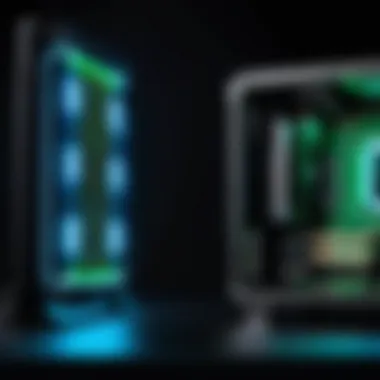Illuminating the Future: Trends in Light Tech and Esports


Intro
The world of technology is rapidly changing, and within this whirlwind of advancement, one aspect often overlooked is the role of light. In gaming and esports, light technology influences everything from hardware performance to immersive game experiences. The nuances of this technology shape the way players interact with their games and how they perceive their environment. This article investigates these developments and articulates their significance in both gaming hardware and player engagement.
Esports Coverage
Esports has transformed from a niche interest to a global phenomenon. Lighting technology plays a pivotal role in enhancing the viewing experience, both for in-person audiences and for those watching live streams.
Pro-Gaming Tournaments
Major tournaments, such as the League of Legends World Championship, often incorporate elaborate lighting setups. These setups not only enhance the atmosphere but also serve a functional purpose. Proper lighting can highlight player performances and create dramatic contrasts that make the experience more visually appealing.
Player Profiles and Interviews
Understanding the players behind the screens allows fans to connect on a deeper level. Interviews often take place in carefully designed environments where lighting is tailored to create a particular mood. Whether highlighting victory or a moment of reflection, the right light can convey emotions effectively.
Team Strategies and Analysis
In modern esports, strategic approaches hinge on understanding the map and enemy patterns. Good lighting in-game assists players in spotting crucial details, influencing their tactics. Teams invest in professional setups that optimize how light conditions can sway gaming performance.
Hardware Testing
The technological backbone of gaming relies heavily on hardware. Various components directly interact with lighting, making hardware testing a crucial aspect to understand.
Reviews of Gaming Monitors
A gaming monitor's brightness, contrast, and color accuracy are essential metrics. Many modern monitors, such as the ASUS ROG Swift PG259QN, feature advanced lighting technology that elevates color fidelity. These factors allow gamers to immerse themselves fully in the experience.
Performance Analysis of GPUs
Graphics Processing Units, like the NVIDIA GeForce RTX 3080, utilize ray tracing technology to enhance lighting effects in games. Performance analysis in real-time scenarios reveals the stark differences in gameplay experiences and graphics quality.
Comparison of Mechanical Keyboards
Mechanical keyboards are not just about tactile feedback; RGB lighting has become a prominent feature. Keyboards, like the Corsair K95 RGB Platinum, provide customizable lighting effects that can enhance gameplay immersion and aesthetic appeal.
Game Reviews
The gaming landscape is always evolving with new releases that push the boundaries of creativity and technology. The use of light is often central to a game's success.
Latest Game Releases
Games such as "Cyberpunk 2077" and "The Legend of Zelda: Breath of the Wild" have made headlines not just for their gameplay but also for innovative lighting techniques. The careful crafting of light not only enhances realism but also affects player orientation and emotional engagement.
Detailed Gameplay Analysis
Examining how light adapts in real-time during gameplay can help players understand maps better. Shadows and lighting dynamics guide player behavior and strategy, making in-game lighting a critical element.
Storyline and Graphics Review
Storytelling in games is often intertwined with visual design. Light can signify transitions in a game's narrative, creating a seamless flow that engulfs players in the world created by developers. Well-designed lighting can evoke specific emotions, enhancing the storytelling experience.
"Lighting can transform a basic gaming experience into an engaging narrative that resonates with players long after they stop playing."
By recognizing the importance of light technology, industry professionals, gamers, and enthusiasts can better appreciate its impact across gaming and esports realms. As advancements continue, understanding these dynamics will ensure a competitive edge in the ever-evolving landscape.
Prologue to Light Technology
Light technology plays a crucial role in today's gaming and esports environment. It influences not just the aesthetic quality of games but also contributes to their functionality and player experience. This section serves as a foundation, outlining how advancements in lighting can enhance the immersive quality of gaming.
The integration of light technology into gaming hardware and environments provides various benefits. These include improved visibility, energy efficiency, and the elevation of overall user engagement.


Defining Light Technology in Gaming
Light technology in gaming encompasses a range of innovations, from basic illumination to complex dynamic lighting effects integrated into games and gaming setups. This technology is not simply about brightness; it involves the manipulation of light to create atmosphere, guide player attention, and facilitate the overall experience of a game.
For instance, LED lighting has become indispensable in gaming peripherals, enhancing visual feedback during gameplay. This shift toward smart lighting solutions allows developers to craft visually stunning environments and experiences that enhance the overall gameplay.
Historical Context of Light Integration
To understand the current state of light technology in gaming, it is helpful to consider its historical context. Early video games featured basic graphics with limited use of light. The simplicity was functional but did not offer depth. As technology advanced, so did the use of light integration in games.
The introduction of 3D graphics in the late 1990s marked a significant turning point. Game developers began experimenting with lighting techniques, such as real-time shadows and dynamic lighting effects, transforming the visual landscape of games. Over time, increased hardware capabilities facilitated even more sophisticated uses of lighting, leading to the immersive environments we see today.
Overall, understanding how light technology has evolved sets the stage for examining its current trends and implications in both technology and esports.
Current Trends in Lighting Technologies
The domain of lighting technologies in gaming and esports is evolving at an impressive pace. As developers and tech enthusiasts recognize the influence of lighting, they are pushing boundaries to create immersive experiences. Trends in lighting technologies not only enhance visual appeal but also impact game mechanics and player interaction. Thus, understanding these trends is essential for both developers and players who seek to maximize their experiences.
LED Lighting Innovations
The rise of LED lighting has revolutionized the gaming landscape. LEDs are increasingly popular due to their efficiency and versatility. They consume less energy while providing brighter and more vibrant colors. This shift from traditional lighting sources has led to innovative applications in both gaming hardware and environments.
Consider the impact on gaming peripherals. Devices like Razer's RGB keyboards and Logitech’s gaming mice use LED lighting to offer customizable effects. These features do not merely satisfy aesthetic needs; they can enhance gameplay by providing visual feedback. For instance, a keyboard might light up under certain conditions in-game, alerting a player to critical status changes.
Moreover, LEDs play a role in thermal management. By using LEDs, companies can create devices that run cooler and are more energy-efficient. This is particularly relevant for high-performance gaming PCs that require effective heat dissipation while maintaining performance under load. The efficiency of LEDs also allows for longer-lasting hardware, reducing waste and benefiting the environment.
Smart Lighting Solutions
Then we look at smart lighting solutions. Smart lighting technologies continue to change how gamers interact with their environments. Systems such as Philips Hue can sync lighting with gameplay, creating an immersive experience that responds to in-game actions. This adds another layer to the gaming experience, allowing players to feel the game's atmosphere deeply.
Smart lighting can also benefit game design. Developers can create dynamic environments that react to player decisions or outcomes. For instance, a brighter light can indicate progress, while dim lighting can create a sense of danger. This kind of interaction fosters a deeper connection between the player and the game world.
Another important aspect is the integration of smart lighting with streaming. Content creators leverage smart lighting to enhance their setups, making the visual element of their streams more engaging. This not only attracts viewers but also aligns with the viewer's emotions during high-stakes moments.
"The integration of smart lighting in gaming is not just about aesthetics; it influences engagement and player immersion."
Impact of Lighting on Hardware Performance
Lighting plays a crucial role in how gaming hardware performs. As the demand for visually stunning games increases, developers must consider how lighting can affect both hardware efficiency and gameplay experiences. Various lighting technologies contribute to enhancing the aesthetic quality of games while also optimizing how hardware functions.
Power Efficiency in Gaming Hardware
One significant benefit of improved lighting technology is its influence on power efficiency within gaming hardware. As manufacturers innovate, LED and other energy-efficient lighting solutions are becoming standard. These advancements lead to reduced energy consumption without sacrificing performance. For instance, gaming graphics cards like the NVIDIA GeForce RTX series incorporate lighting techniques that enhance visuals while keeping energy demands low.
Using energy-efficient light sources can lead to a longer lifespan for gaming setups. This not only benefits the environment through reduced electricity use but also helps gamers save on energy bills. Keeping power efficiency in mind is critical as more devices are added to gaming rigs. Adopting energy-efficient lighting can decrease overall power consumption significantly.
Moreover, many gaming peripherals, such as keyboards and mice, are now designed with RGB lighting that is not only visually appealing but also energy-efficient. This combination results in a pleasant user experience without excessively drawing power.
Thermal Management Through Effective Lighting
Effective lighting can also play a pivotal role in thermal management of gaming hardware. High-performance components generate heat during operation. However, well-designed lighting systems can assist in distributing that heat more evenly. For example, devices like cooling fans may be optimized to work better alongside integrated lighting systems.
Using controlled lighting can indicate system heat levels. If the lighting changes color based on temperature, it provides users with visual cues regarding their hardware’s performance. This is useful for gamers as it allows them to monitor systems efficiently.
In some advanced setups, lighting is integrated with cooling systems. This holistic approach not only improves the visual appeal but also enhances the overall performance of hardware. Users get to enjoy an aesthetically pleasing experience while optimizing thermal management.
Effective lighting not only beautifies the gaming environment but also facilitates better hardware management.
In summary, addressing the impact of lighting on hardware performance is not just about aesthetics. It encompasses power efficiency and enhanced thermal management. Together, these factors contribute to a more efficient gaming experience and ultimately lead to deeper immersion for players. Understanding these aspects is essential as gaming continues to evolve.
Lighting and Game Design


Lighting plays a crucial role in game design, serving not only as a functional aspect but also as an aesthetic cornerstone. It shapes a player's experience, creates atmosphere, and can even influence gameplay mechanics. As technology evolves, developers increasingly leverage advanced lighting techniques to enhance both visual appeal and user engagement.
Role of Lighting in Game Aesthetics
The aesthetics of a game often hinge on how effectively lighting is utilized. Properly designed lighting can enhance realism and immersion, inviting players into the game world. For instance, the dynamic shifting of shadows and highlights can create a more believable setting. The emotional tone of a scene can change dramatically through lighting choices. Bright, colorful scenes can evoke feelings of optimism, while darker, muted palettes can set a tone of tension or foreboding.
- Realism: Games like "The Last of Us Part II" utilize lighting to create a believable environment, imitating how natural light interacts with both objects and characters.
- Atmosphere: In horror games such as "Amnesia: The Dark Descent," dim lighting creates unsettling shadows, fostering anxiety and fear among players.
- Style and Identity: Titles like "Journey" employ unique lighting styles to stand out and convey narrative without relying heavily on dialogue.
Lighting design is a deliberate art form within game development. Attention to how light reflects off surfaces or casts shadows informs mood and player perception.
Lighting as a Gameplay Mechanic
Beyond aesthetics, lighting can serve as a gameplay mechanic. Certain games leverage light to guide players, create obstacles, or even offer strategic advantages. This multifaceted role underscores its importance in design. For example, in "Metal Gear Solid V: The Phantom Pain," players utilize shadows for stealth tactics. The way light and shadow are manipulated encourages creative engagement within the game.
- Stealth Elements: In many stealth games, shadows provide the cover necessary for players to navigate unseen, directly influencing tactics.
- Puzzle Solving: Some games incorporate lighting puzzles. In "Legend of Zelda: Breath of the Wild," players manipulate light to unlock doorways or reveal hidden areas.
- Environmental Storytelling: Lighting can reveal narrative elements, directing the player's focus toward specific areas or objects and enhancing storytelling.
"Lighting is not just about making things visible; it shapes how players interact with and perceive their environment."
Integrating lighting as a gameplay element demonstrates the depth this aspect adds to game design. The implications of lighting extend into how players think and strategize, making it an indispensable tool.
In essence, lighting in game design is a complex interplay of artistry and functionality. It engenders immersive experiences, enriches gameplay, and directly affects how narratives are crafted and understood.
Player Experience and Immersion
The impact of lighting in gaming extends beyond mere aesthetics; it plays a pivotal role in shaping player experiences and enhancing immersion. The correct application of light influences how players perceive their environment, informs their decision-making, and creates a more engaging and emotionally resonant experience.
One primary benefit of effective lighting is its ability to evoke emotional responses. Lighting can create tension or excitement, guiding players through various game scenarios. For instance, a darker environment may instill fear, while a vibrant and well-lit atmosphere can promote feelings of joy or safety. Developers use specific lighting techniques to manipulate players' emotions, making their experience more memorable.
Another aspect to consider is how lighting affects visibility and gameplay. Insufficient lighting can obscure crucial elements within a game. This is especially true in competitive settings where every detail counts. Therefore, balancing lighting and darkness enhances not only aesthetic appeal but also gameplay clarity.
In terms of practical considerations, characters and objects in games benefit from dynamic lighting. Dynamic shadows and highlights contribute to realism, helping players immerse themselves in the game world.
"Lighting can make or break the player's connection to the game. It's crucial for developers to pay attention to its nuances."
Players often have different preferences regarding brightness and contrast. Some may prefer vibrant colors, while others lean toward muted tones. Hence, providing adjustable lighting settings can accommodate preferences, enhancing overall satisfaction.
Psychological Effects of Lighting in Games
Lighting influences players on psychological levels. Bright environments are often associated with positivity and exploration, encouraging players to engage more with the game world. Conversely, low-light settings can create a sense of danger, urging caution.
Some studies indicate that well-designed lighting can boost player performance. A bright and inviting atmosphere may improve focus and reaction times, which is vital in fast-paced gaming scenarios. Moreover, the strategic use of light can mitigate feelings of frustration, as it enhances visual clarity, allowing players to navigate complex environments more easily.
Also, the rhythmic alteration of lighting can synchronize with gameplay to maintain engagement. For example, dramatic lighting changes during key moments can amplify emotional stakes, creating a more immersive gaming experience.
User Interface and Visual Clarity Enhancements
The role of light extends to user interface design as well. Good lighting can significantly enhance visual clarity for HUD elements, making information easily discernible without straining the player's eyes.
Developers are increasingly using contrasting light to improve the visibility of critical interface components. This is essential in competitive gaming, where split-second decisions can lead to victory or defeat. An intuitive interface allows players to focus on gameplay rather than deciphering their surroundings.
Furthermore, adaptive lighting in user interfaces can enhance usability. For instance, changing light intensity based on specific game conditions ensures relevant information is always easily accessible. This ensures players remain in the action rather than getting caught up in interface challenges.
Case Studies of Lighting in Esports
Lighting plays an essential role in shaping the dynamic environment of esports. It not only enhances the visual appeal but also significantly impacts the overall experience for players and spectators alike. Through detailed case studies, we can identify key elements that highlight the integration of light technology within esports events. By understanding these applications, we can better appreciate the intricate relationship between lighting and the competitive gaming world.
Analysis of Major Tournaments
Major esports tournaments serve as the ultimate testing grounds for innovative lighting technologies. Events like the League of Legends World Championship or The International for Dota 2 showcase elaborate lighting designs that transform venues into immersive experiences.
One key observation is the use of adaptive lighting systems that adjust according to in-game events. For example, in a high-stakes match, the intensity and color of the lights might shift dramatically with crucial moments, enhancing emotional engagement for both players and fans. This method improves atmospheric tension and keeps spectators on the edge of their seats.


Moreover, lighting design is not just limited to the gameplay area. The overall architecture of esports arenas is often coupled with intricate layout designs of lights that provide a coherent visual narrative throughout the entire venue. This synchronization helps keep the audience focused and engaged as they visually transition between different elements of the event.
In addition, analysis of tournaments reveals how sustainability integrates into lighting choices, with some events opting for energy-efficient LED systems. This serves dual purposes: reducing energy costs and minimizing the environmental impact of hosting large-scale esports events.
Impact on Spectator Experience
The spectator experience in esports is crucial, as it often dictates the overall success of an event. Effective lighting not only enhances the aesthetic appeal but also helps convey gameplay dynamics to the audience.
Consider the use of color theory in lighting choices. Colors can evoke different emotional responses. For instance, a warm orange hue might create a feeling of excitement, while cooler tones can instill calmness. This technique can be particularly useful during critical gameplay moments when the atmosphere must resonate with the tension in the game.
Incorporating real-time visuals with lighting can further amplify the experience. When the lights respond to in-game actions, this synchronicity provides an engaging narrative layer for spectators. Fans watching the match experience an almost multi-sensory involvement, where sounds, visuals, and emotions blend seamlessly.
Additionally, the positioning and intensity of lights are important to ensure that spectators have an unobstructed view of both the players and the screens. Negative experiences, such as glare or distractions from ill-placed lights, can detract from the overall enjoyment. Thus, careful consideration of lighting placement significantly enhances viewing experiences, ensuring clarity and focus on the action.
"The evolution of lighting in esports is critical to sustaining viewer engagement and creating memorable moments that resonate with players and audiences alike."
Future Trends in Light Technology
The domain of light technology is witnessing a significant evolution that promises to reshape the landscape of gaming and esports. Understanding these trends is crucial for stakeholders, including game developers, hardware manufacturers, and players. Innovations in light technology not only enhance aesthetic appeal but also improve functionality and player experience. Embracing these changes can lead to more immersive environments and optimized hardware performance.
Emerging Technologies on the Horizon
Several exciting technologies are emerging in the light sector, set to impact gaming. For instance, MicroLED displays are gaining traction due to their superior brightness and energy efficiency. This technology allows for higher contrast ratios and less power usage, making it ideal for gamers seeking quality visual experience.
Another notable trend is the integration of augmented reality (AR) and virtual reality (VR) with adaptive lighting. Developers are leveraging this technology to create dynamic lighting environments that respond to player actions. This not only creates a more engaging atmosphere but also enhances gameplay mechanics.
Additionally, smart lighting solutions are becoming prominent. With features such as customizable light patterns, gamers can set their environment to match game moods or personal preferences. This customization leads to an enhanced personal experience, making each gaming session unique.
Potential Impacts on Game Development
The effects of advancing light technology extend beyond visual appeal. As developers integrate these advancements, several implications emerge for game production and design.
- Enhanced Creativity: Developers can utilize sophisticated lighting technologies to create intricate and visually stunning worlds. This opens doors for developing new types of gameplay that rely on light interactions.
- Realistic Environments: Advanced light modeling can enhance realism in games. This contributes to immersive storytelling, as lighting sets the mood and helps convey emotions within the game narrative.
- Accessibility Improvements: With better light technology, games can become more accessible. Well-designed lighting can aid players with visual impairments by providing clearer contrasts and highlighting important visual cues.
"The future of gaming light technology will influence not just how we play, but the very nature of game design itself."
Ultimately, the fusion of light technology with game development heralds a new era of gaming. Developers who adapt early to these trends will not only attract more players but also enhance the overall gaming experience.
Environmental Considerations
The role of environmental considerations in light technology is crucial in the present age. With climate change and resource depletion becoming pressing issues, the technology sector is under increased scrutiny. The integration of energy-efficient lighting solutions in gaming and esports not only promotes sustainability but also reflects socially responsible practices. Therefore, understanding this topic is important for both manufacturers and gamers who wish to contribute to a more sustainable future.
Sustainability in Light Technology Production
Sustainability in light technology production encompasses several factors. Manufacturers are increasingly adopting eco-friendly materials in the creation of lighting products. This includes using recycled materials and reducing toxic chemicals. Efforts to minimize waste during the production process also play a significant role.
Furthermore, companies are embracing life-cycle assessments. These assessments evaluate the environmental impacts from the beginning of production to the end of a product's life. This means that everything, from sourcing raw materials to the product's energy efficiency, is scrutinized for its ecological footprint. The use of Light Emitting Diodes, or LEDs, exemplifies this trend. LEDs use less energy compared to traditional bulbs, leading to significant savings in both electricity and costs over time.
Energy Consumption Challenges
Despite the advancements in lighting technology, energy consumption remains a challenge. As gaming hardware becomes more powerful, the demand for energy-efficient lighting solutions increases. This can often lead to a paradox where the benefits of lower consumption in one area are negated by increased usage in another.
Additionally, energy consumption issues are compounded by the growing prevalence of smart lighting systems. These systems often come with enhanced features that, while beneficial, can lead to increased energy usage if not managed properly. It is crucial for manufacturers to maintain a balance between functionality and energy efficiency. Efforts to address energy consumption can involve creating systems that optimize their use of electricity during peak and off-peak hours, ensuring that energy demands do not place undue stress on the grid.
"As the gaming community evolves, so must our responsibility towards sustainable practices in technology.
Closure
In the realm of gaming and esports, the role of light technology is often overlooked. However, this article highlights how essential it is to both hardware performance and player immersion. Effective lighting can elevate user experience significantly and influences both game design and hardware functionality.
Recap of Key Insights
- Technological Advancements: Recent innovations, particularly in LED and smart lighting technologies, are reshaping how players interact with games and how these games are designed.
- Hardware Efficiency: By focusing on thermal management and power efficiency, modern lighting solutions have enhanced the longevity and performance of gaming hardware.
- User Experience and Gameplay Mechanics: Lighting has a direct impact on player psychology and gameplay. It can alter perceptions and affect a game’s narrative.
- Environmental Considerations: Sustainability in production and energy consumption challenges are relevant. The industry is gradually recognizing the importance of adopting eco-friendly practices.
"As technology evolves, light technology remains a crucial component in defining the gaming experience, operating silently in the background yet shaping reality for players."
Final Thoughts on the Future of Light Technology
The future of light technology appears promising. Emerging technologies on the horizon, such as adaptive lighting systems, are likely to provide even more immersive environments for players. The potential impacts on game development and esports events cannot be overstated.



